Page 88
Exercise 5.1
Q1. What is the disadvantage in comparing line segments by mere observation?
Answer:
When two line segments of almost same lengths are compared by mere observation, it is difficult to find out which line segment is of greater length. Hence mere observation is not an appropriate method to compare line segments that have a slight difference between their lengths.
Q2. Why is it better to use a divider than a ruler, while measuring the length of a line segment?
Answer:
While using a ruler, the thickness of the ruler may cause difficulties in reading the marks. Error can also occur due to angular viewing that is incorrect positioning of the eye while taking the reading. Therefore, while measuring the length of a line segment, it is better to use a divider than a ruler.
Q3. Draw any line segment, say AB. Take any point C lying in between A and B. Measure the lengths of AB, BC and AC. Is AB = AC + CB? [Note : If A,B,C are any three points on a line such that AC + CB = AB, then we can be sure that C lies between A and B.]
Answer:
 It is given that point C is lying between A and B.
It is given that point C is lying between A and B.
 We can see that all these points are lying on the same line segment AB. Therefore, for every situation in which point C is lying in between A and B, it may be said that AB = AC + CB.
We can see that all these points are lying on the same line segment AB. Therefore, for every situation in which point C is lying in between A and B, it may be said that AB = AC + CB.
For example,
If AB = 5 cm
C is 2 cm away from point A so, AC = 2 cm.
AB = AC + BC
So, BC = AB – AC = 5 – 2 = 3 cm
AB = 2 + 3 = 5
Therefore, relation AB = AC + BC is verified.
Q4. If A,B,C are three points on a line such that AB = 5 cm, BC = 3 cm and AC = 8 cm, which one of them lies between the other two?
Answer:
Given:
AB = 5 cm
BC = 3 cm
AC = 8 cm
Here, AC = AB + BC
Therefore, point B lies between A and C.
Q5. Verify, whether D is the mid-point of AG.
 Answer:
Answer:
Given:
= 4 – 1 = 3 units
= 7 – 4 = 3 units
= 7 – 1 = 6 units
Therefore, D is the mid-point of .
Q6. If B is the mid-point of and C is the mid-point of , where A, B, C, D lie on a straight line, say why AB = CD?
Answer:
 Since, B is the mid-point of AC, therefore,
Since, B is the mid-point of AC, therefore,
AB = BC …(i)
Since C is the midpoint of BD, therefore,
BC = CD …(ii)
From equation (i) and (ii), we can say that
AB = CD
Q7. Draw five triangles and measure their sides. Check in each case, if the sum of the lengths of any two sides is always less than the third side.
Answer:

Page 91
Exercise 5.2
Q1. What fraction of a clockwise revolution does the hour hand of a clock turn through, when it goes from
(a) 3 to 9 (b) 4 to 7 (c) 7 to 10
(d) 12 to 9 (e) 1 to 10 (f) 6 to 3
Answer:
(a) 3 to 9 - or two right angles
(b) 4 to 7 -
or one right angle
(c) 7 to 10 -
or one right angle
(d) 12 to 9 -
or three right angles
(e) 1 to 10 -
or three right angles
(f) 6 to 3 -
or three right angles
Q2. Where will the hand of a clock stop if it
(a) starts at 12 and makes 1/2 of a revolution, clockwise?
(b) starts at 2 and makes 1/2 of a revolution, clockwise?
(c) starts at 5 and makes 1/4 of a revolution, clockwise?
(d) starts at 5 and makes 3/4 of a revolution, clockwise?
Answer:
(a) At 6
(b) At 8
(c) At 8
(d) At 2
Q3. Which direction will you face if you start facing
(a) east and make 1/2 of a revolution clockwise?
(b) east and make 1 and a 1/2 of a revolution clockwise?
(c) west and make 3/4 of a revolution anti-clockwise?
(d) south and make one full revolution?
(Should we specify clockwise or anti-clockwise for this last question? Why not?)
Answer:
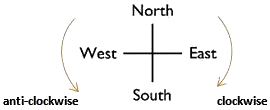 (a) West
(a) West
(b) West
(c) North
(d) South
Q4. What part of a revolution have you turned through if you stand facing
(a) east and turn clockwise to face north?
(b) south and turn clockwise to face east?
(c) west and turn clockwise to face east?
Answer:
 (a)
(a)
(b)
(c)
Q5. Find the number of right angles turned through by the hour hand of a clock when it goes from
(a) 3 to 6 (b) 2 to 8 (c) 5 to 11
(d) 10 to 1 (e) 12 to 9 (f) 12 to 6
Answer:
(a) One right angle
(b) Two right angles
(c) Two right angles
(d) One right angle
(e) Three right angles
(f) Two right angles
Q6. How many right angles do you make if you start facing
(a) south and turn clockwise to west?
(b) north and turn anti-clockwise to east?
(c) west and turn to west?
(d) south and turn to north?
Answer:
anti-clockwise clockwise
(a) One right angle
(b) Three right angles
(c) Four right angles
(d) Two right angles
Q7. Where will the hour hand of a clock stop if it starts
(a) from 6 and turns through 1 right angle?
(b) from 8 and turns through 2 right angles?
(c) from 10 and turns through 3 right angles?
(d) from 7 and turns through 2 straight angles?
Answer:
(a) At 9
(b) At 2
(c) At 7
(d) At 7
Page 94
Exercise 5.3
Match the following :
|
(i) Straight angle
|
(a) Less than one-fourth of a revolution
|
|
(ii) Right angle
|
(b) More than half a revolution
|
|
(iii) Acute angle
|
(c) Half of a revolution
|
|
(iv) Obtuse angle
|
(d) One-fourth of a revolution
|
|
(v) Reflex angle
|
(e) Between 1/4 and 1/2 of a revolution
|
|
|
(f) One complete revolution
|
Answer:
|
(i) Straight angle
|
(c) Half of a revolution
|
|
(ii) Right angle
|
(d) One-fourth of a revolution
|
|
(iii) Acute angle
|
(a) Less than one-fourth of a revolution
|
|
(iv) Obtuse angle
|
(e) Between 1/4 and 1/2 of a revolution
|
|
(v) Reflex angle
|
(b) More than half a revolution
|
(i) Straight angle is an angle equal to two right angles that is 180° which is considered as a straight line and half of revolution is equal to 180°.
(ii) Right angle is an angle equal to 90°. The value of one-fourth of a revolution is also 90°.
(iii) Acute angle is an angle which is less than 90°. The value that is less than one-fourth of a revolution is the angle less than 90°.
(iv) Obtuse angle is an angle which is greater than 90° and less than 180°. The value between 1/4 and 1/2 of a revolution also lie between 90° and 180°.
(v) Reflex angle - The angle which is greater than 180° but less than 360° is called reflex angle. More than half a revolution is the angle whose measure is greater than 180°.
Q2. Classify each one of the following angles as right, straight, acute, obtuse or reflex :
Answer:
(a) Less than 90° so Acute angle
(b) Greater than 90° and less than 180° so Obtuse angle
(c) Equal to 90° so Right angle
(d) Greater than 180° but less than 360° so Reflex angle
(e) Equal to 180° so Straight angle
(f) Less than 90° so Acute angle
Page 97
Exercise 5.4
Q1. What is the measure of (i) a right angle? (ii) a straight angle?
Answer:
(i) A right angle measures 90°.
(ii) A straight line measures 180°.
Q2. Say True or False :
(a) The measure of an acute angle < 90°.
(b) The measure of an obtuse angle < 90°.
(c) The measure of a reflex angle > 180°.
(d) The measure of one complete revolution = 360°.
(e) If m∠A = 53° and m∠B = 35°, then m∠A > m∠B.
Answer:
(a) True, Acute angle measures less than 90°.
(b) False, Obtuse angle measures more than 90°.
(c) True, Reflex angle measures greater than 180°.
(d) True, One complete revolution measures 360°.
(e) True, If m∠A = 54° and m∠B = 36°, then m∠A is greater than m∠B.
Q3. Write down the measures of
(a) some acute angles.
(b) some obtuse angles.
(give at least two examples of each).
Answer:
(i) Acute angles: 30° and 54°.
(ii) Obtuse angles: 120° and 165°.
Q4. Measure the angles given below using the Protractor and write down the measure.
Answer:
(a) 40°
(b) 130°
(c) 90°
(d) 60°, 150° and 75°.
Q5. Which angle has a large measure? First estimate and then measure.
Measure of Angle A =
Measure of Angle B =
Answer:
∠B has the largest angle.
A = 40°
B = 60°
Q6. From these two angles which has larger measure? Estimate and then confirm by measuring them.
![]() Answer:
Answer:
The angles measure 75° and 70°.
Hence, the first angle is greater.
Q7. Fill in the blanks with acute, obtuse, right or straight :
(a) An angle whose measure is less than that of a right angle is______.
(b) An angle whose measure is greater than that of a right angle is ______.
(c) An angle whose measure is the sum of the measures of two right angles is _____.
(d) When the sum of the measures of two angles is that of a right angle, then each one of them is ______.
(e) When the sum of the measures of two angles is that of a straight angle and if one of them is acute then the other should be _______.
Answer:
(a) An angle whose measure is less than that of a right angle is Acute angle.
(b) An angle whose measure is greater than that of a right angle is Obtuse angle.
(c) An angle whose measure is the sum of the measures of two right angles is Straight Angle.
(d) When the sum of the measures of two angles is that of a right angle, then each one of them is Acute angle.
(e) When the sum of the measures of two angles is that of a straight angle and if one of them is acute then the other should be Obtuse angle.
Q8. Find the measure of the angle shown in each figure. (First estimate with your eyes and then find the actual measure with a protractor).
Answer:
The angle measures
(i) 30°.
(ii) 120°.
(iii) 60°.
(iv) 180°.
Q9. Find the angle measure between the hands of the clock in each figure :
Answer:
(i) 90°.
(ii) 30°.
(iii) 180°.
Q10. Investigate In the given figure, the angle measures 30°. Look at the same figure through a magnifying glass. Does the angle becomes larger? Does the size of the angle change?
Answer:
The angle does not change.
Q11. Measure and classify each angle :
|
Angle
|
Measure
|
Type
|
|
∠AOB
|
|
|
|
∠AOC
|
|
|
|
∠BOC
|
|
|
|
∠DOC
|
|
|
|
∠DOA
|
|
|
|
∠DOB
|
|
|
Answer:
|
Angle
|
Measure
|
Type
|
|
∠AOB
|
50°
|
Acute
|
|
∠AOC
|
130°
|
Obtuse
|
|
∠BOC
|
80°
|
Acute
|
|
∠DOC
|
100°
|
Obtuse
|
|
∠DOA
|
145°
|
Obtuse
|
|
∠DOB
|
180°
|
Straight
|
Page 99
Exercise 5.5
Q1. Which of the following are models for perpendicular lines :
(a) The adjacent edges of a table top.
(b) The lines of a railway track.
(c) The line segments forming the letter ‘L’.
(d) The letter V.
Answer:
(a) Yes, the adjacent edges of a table top are perpendicular.
(b) No, the lines of a railway track are not perpendicular.
(c) Yes, the line segments forming the letter ‘L’ are perpendicular.
(d) No, the lines in the letter ‘V’ are not perpendicular.
Q2. Let PQ be the perpendicular to the line segment XY . Let PQ and XY intersect in the point A. What is the measure of ∠PAY ?
Answer:
∠PAY=90°
Q3. There are two set-squares in your box. What are the measures of the angles that are formed at their corners? Do they have any angle measure that is common?
Answer:
The angles present in first set-square are 45°, 90°, 45° and another set-square has 60°, 90°, 30°.
The common angle between them is 90°.
Q4. Study the diagram. The line l is perpendicular to line m
(a) Is CE = EG?
(b) Does PE bisect CG?
(c) Identify any two line segments for which PE is the perpendicular bisector.
(d) Are these true?
(i) AC > FG
(ii) CD = GH
(iii) BC < EH.
Answer:
(a) Yes, the measure of both is 2 units.
(b) Yes, because CE = EG
(c)
(d) (i)True, AC > FG.
(ii) True, CD = GH.
(iii) True, BC < EH.
Page 103
Exercise 5.6
Q1. Name the types of following triangles :
(a) Triangle with lengths of sides 7 cm, 8 cm and 9 cm.
(b) ΔABC with AB = 8.7 cm, AC = 7 cm and BC = 6 cm.
(c) ΔPQR such that PQ = QR = PR = 5 cm.
(d) ΔDEF with m∠D = 90°
(e) ΔXYZ with m∠Y = 90° and XY = YZ.
(f) ΔLMN with m∠L = 30°, m∠M = 70° and m∠N = 80°.
Answer:
(i) As the triangle has all three sides unequal it is a Scalene triangle.
(ii) As the triangle has all three sides unequal it is a Scalene triangle.
(iii) As all three sides are equal it is an Equilateral triangle.
(iv) Since m∠D = 90° so it is a right angled triangle.
(v) Since two sides are equal and one angle measures 90° it is an Isosceles right-angled triangle.
(vi Since all the angles are less than 90° it is an Acute-angled triangle.
Q2. Match the following :
|
Measures of Triangle
|
Type of Triangle
|
|
(i) 3 sides of equal length
|
(a) Scalene
|
|
(ii) 2 sides of equal length
|
(b) Isosceles right angled
|
|
(iii) All sides are of different length
|
(c) Obtuse angled
|
|
(iv) 3 acute angles
|
(d) Right angled
|
|
(v) 1 right angle
|
(e) Equilateral
|
|
(vi) 1 obtuse angle
|
(f) Acute angled
|
|
(vii) 1 right angle with two sides of equal length
|
(g) Isosceles
|
Answer:
|
Measures of Triangle
|
Type of Triangle
|
|
(i) 3 sides of equal length
|
(e) Equilateral
|
|
(ii) 2 sides of equal length
|
(g) Isosceles
|
|
(iii) All sides are of different length
|
(a) Scalene
|
|
(iv) 3 acute angles
|
(f) Acute angled
|
|
(v) 1 right angle
|
(d) Right angled
|
|
(vi) 1 obtuse angle
|
(c) Obtuse angled
|
|
(vii) 1 right angle with two sides of equal length
|
(b) Isosceles right angled
|
Q3. Name each of the following triangles in two different ways: (you may judge the nature of the angle by observation)
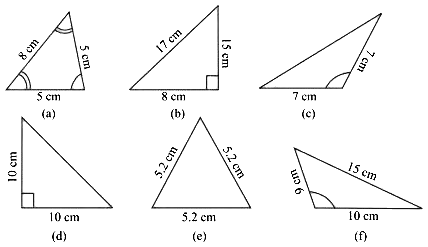 Answer:
Answer:
(i) Isosceles triangle and Acute angled triangle
(ii) Scalene triangle and Right-angled triangle
(iii) Isosceles triangle and Obtuse-angled triangle
(iv)Isosceles triangle and Right-angled triangle
(v) Acute angled triangle and Equilateral triangle
(vi)Scalene triangle and Obtuse-angled triangle
Q4. Try to construct triangles using match sticks. Some are shown here.
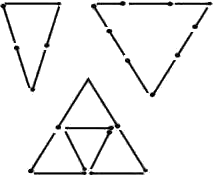 Can you make a triangle with
Can you make a triangle with
(a) 3 matchsticks?
(b) 4 matchsticks?
(c) 5 matchsticks?
(d) 6 matchsticks?
(Remember you have to use all the available matchsticks in each case)
Name the type of triangle in each case. If you cannot make a triangle, think of reasons for it.
Answer:
(i) For 3 matchsticks
An acute angle triangle is formed with 3 matchsticks because the sum of the two sides is greater than the third side.
(ii) For 4 matchsticks
By using 4 matchsticks a square is formed, so therefore it is not possible in this case.
(iii) For 5 matchsticks
An acute angle triangle is formed with the help of 5 matchsticks because in this case the sum of the two sides is greater than the third side.
(iv) For 6 matchsticks
An acute angle triangle is formed with the help of 6 matchsticks because in this case the sum of the two sides is greater than the third side.
Page 106
Exercise 5.7
Q1. Say True or False :
(a) Each angle of a rectangle is a right angle.
(b) The opposite sides of a rectangle are equal in length.
(c) The diagonals of a square are perpendicular to one another.
(d) All the sides of a rhombus are of equal length.
(e) All the sides of a parallelogram are of equal length.
(f) The opposite sides of a trapezium are parallel.
Answer:
(i) True, in a rectangle each angle is a right angle.
(ii) True, in a rectangle the opposite sides are equal in length.
(iii) True, in a square the diagonals are perpendicular to each another.
(iv) True, in a rhombus all the sides are equal in length.
(v) False, in a parallelogram all the sides are not equal in length. The opposite sides of a parallelogram are of equal length and the opposite angles of a parallelogram are of equal measure.
(vi) False, a trapezium has only one pair of parallel sides.
Q2. Give reasons for the following :
(a) A square can be thought of as a special rectangle.
(b) A rectangle can be thought of as a special parallelogram.
(c) A square can be thought of as a special rhombus.
(d) Squares, rectangles, parallelograms are all quadrilaterals.
(e) Square is also a parallelogram.
Answer:
(i) A square has four equal sides and four equal angles and can be thought of as a special rectangle in which two adjacent sides have equal length.
(ii) A rectangle has its opposite sides equal as well as parallel and so can be thought of as a special parallelogram.
(iii) A square has all sides equal in length and all interior angles right angles. A rhombus has all sides equal in length. So a square can be thought of as a special rhombus since all four of its sides are of the same length.
(iv) A quadrilateral is made up of four line segments and since squares, rectangles and parallelograms have four sides each they are all quadrilaterals.
(v) Square is also a parallelogram as its opposite sides are equal as well as parallel.
Q3. A figure is said to be regular if its sides are equal in length and angles are equal in measure. Can you identify the regular quadrilateral?
Answer:
A quadrilateral has four sides. A square has four equal sides and four equal angles so we can say that a square is a regular quadrilateral.
Page 108
Exercise 5.8
Q1. Examine whether the following are polygons. If any one among them is not, say why?
 Answer:
Answer:
(a) The shape is not a polygon because the figure is not closed.
(b) The shape is a polygon because it is closed by line segments.
(c) The shape is not a polygon because the figure is not made up of line segments.
(d) The shape is not a polygon because the figure is not entirely made up of line segments.
Q2. Name each polygon. Make two more examples of each of these.
 Answer:
Answer:
(a) Quadrilateral
(b) Triangle
(c) Pentagon
(d) Octagon
Q3. Draw a rough sketch of a regular hexagon. Connecting any three of its vertices, draw a triangle. Identify the type of the triangle you have drawn.
Answer:
 123456 is a regular hexagon and triangle thus formed by joining 165 is an isosceles triangle.
123456 is a regular hexagon and triangle thus formed by joining 165 is an isosceles triangle.
Q4. Draw a rough sketch of a regular octagon. (Use squared paper if you wish). Draw a rectangle by joining exactly four of the vertices of the octagon.
Answer:
 12345678 is a regular shaped octagon and 3456 is a regular shaped rectangle.
12345678 is a regular shaped octagon and 3456 is a regular shaped rectangle.
Q5. A diagonal is a line segment that joins any two vertices of the polygon and is not a side of the polygon. Draw a rough sketch of a pentagon and draw its diagonals.
Answer:
 12345 is the required pentagon and its diagonals are 1 4, 1 3, 2 5 and 2 4.
12345 is the required pentagon and its diagonals are 1 4, 1 3, 2 5 and 2 4.
Page 111
Exercise 5.9
Q1. Match the following :
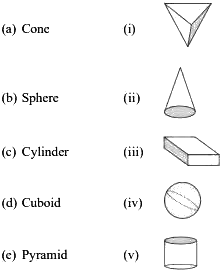 Give two new examples of each shape.
Give two new examples of each shape.
Answer:
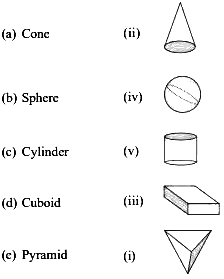
Q2. What shape is
(a) Your instrument box?
(b) A brick?
(c) A match box?
(d) A road-roller?
(e) A sweet laddu?
Answer:
(a) Cuboid
(b) Cuboid
(c) Cuboid
(d) Cylinder
(e) Sphere